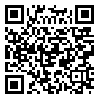Volume 7, Issue 2 (2021)
Pharm Biomed Res 2021, 7(2): 105-114 |
Back to browse issues page
Download citation:
BibTeX | RIS | EndNote | Medlars | ProCite | Reference Manager | RefWorks
Send citation to:



BibTeX | RIS | EndNote | Medlars | ProCite | Reference Manager | RefWorks
Send citation to:
Alamholo M, Amraie Y. Evaluation of Susceptibility and Resistance of Human Infectious Bacteria and Identification of Bioactive Compounds in Pistacia atlantica, Cassia absus, and Quercus persica. Pharm Biomed Res 2021; 7 (2) :105-114
URL: http://pbr.mazums.ac.ir/article-1-380-en.html
URL: http://pbr.mazums.ac.ir/article-1-380-en.html
1- Department of Biotechnology, Institute of Science and Modern Technology, Rojava University, Qamishlo, Syria.
2- Department of Plant Biotechnology, Faculty of Agriculture, Bu-Ali Sina University, Hamadan, Iran.
2- Department of Plant Biotechnology, Faculty of Agriculture, Bu-Ali Sina University, Hamadan, Iran.
Abstract: (5495 Views)
Background: The antimicrobial activity of plants has long been considered an effective mechanism for controlling pathogenic microorganisms.
Objectives: This study aimed to identify phytochemical compounds of the seed extracts from ethnomedicinal plants of Pistacia atlantica, Cassia absus, and Quercus persica with Gas Chromatography-Mass Spectrometry (GC-MS) and investigation of their antibacterial and antioxidant activities.
Methods: The seeds were collected from Lorestan Province, Iran. Their antibacterial and anti-radical activities were analyzed by disk-diffusion and 2,2-diphenyl-1-picrylhydrazyl assays, respectively. Ethanol (96%), methanol (80%), and distilled water extracts were obtained by the maceration method. The methanol extract was used for the analysis of chemical compositions.
Results: About 40, 31, and 8 compounds were identified by GC-MS in the seeds of C. absus, P. atlantica, and Q. persica, respectively. Results indicated that 2,4-di-tert-butylphenol (36.043%) and tetradecanoic acid (4.92%) were dominated in the seed extracts of C. absus. However, germacyclopetene (38.119%) and 1,2,3-benzenetriol (8.115%) were dominated in the seed extracts of P. atlantica. Furthermore, 5H-tetrazole-5-thione, 1,4-dihydro-1,4-dimethy (38.505%), and tetradecanoic acid (30.546%) were dominated in the seed extracts of Q. persica. The highest inhibitory activity against Micrococcus luteus was observed on the methanol extract of C. absus with ascorbic acid. A significant difference was observed between the Inhibitory Concentration (IC50) values of methanol extract of C. absus with ascorbic acid.
Conclusion: Because of the presence of antimicrobial compounds in the tested ethnomedicinal plants, they can be used to synthesize new antimicrobial drugs in medicinal and pharmaceutical sciences.
Objectives: This study aimed to identify phytochemical compounds of the seed extracts from ethnomedicinal plants of Pistacia atlantica, Cassia absus, and Quercus persica with Gas Chromatography-Mass Spectrometry (GC-MS) and investigation of their antibacterial and antioxidant activities.
Methods: The seeds were collected from Lorestan Province, Iran. Their antibacterial and anti-radical activities were analyzed by disk-diffusion and 2,2-diphenyl-1-picrylhydrazyl assays, respectively. Ethanol (96%), methanol (80%), and distilled water extracts were obtained by the maceration method. The methanol extract was used for the analysis of chemical compositions.
Results: About 40, 31, and 8 compounds were identified by GC-MS in the seeds of C. absus, P. atlantica, and Q. persica, respectively. Results indicated that 2,4-di-tert-butylphenol (36.043%) and tetradecanoic acid (4.92%) were dominated in the seed extracts of C. absus. However, germacyclopetene (38.119%) and 1,2,3-benzenetriol (8.115%) were dominated in the seed extracts of P. atlantica. Furthermore, 5H-tetrazole-5-thione, 1,4-dihydro-1,4-dimethy (38.505%), and tetradecanoic acid (30.546%) were dominated in the seed extracts of Q. persica. The highest inhibitory activity against Micrococcus luteus was observed on the methanol extract of C. absus with ascorbic acid. A significant difference was observed between the Inhibitory Concentration (IC50) values of methanol extract of C. absus with ascorbic acid.
Conclusion: Because of the presence of antimicrobial compounds in the tested ethnomedicinal plants, they can be used to synthesize new antimicrobial drugs in medicinal and pharmaceutical sciences.
Keywords: Gas Chromatography-Mass Spectrometry (GC/MS), Cassia absus, Pistacia atlantica, Quercus persica, Infectious bacteria
Type of Study: Original Research |
Subject:
Medical Chemistry
| Rights and permissions | |
 |
This work is licensed under a Creative Commons Attribution-NonCommercial 4.0 International License. |









